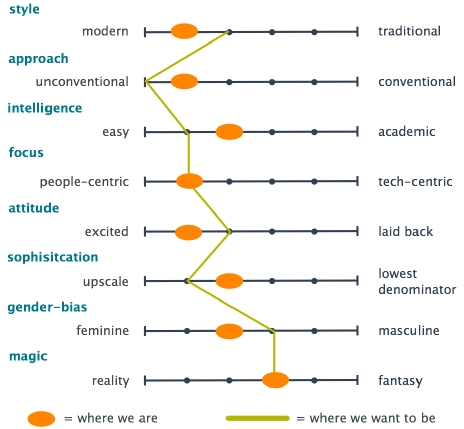I love tools that are simple to use, easy to learn, but offer profound impact. The performance chart is one of those tools. They consists of a group of continua (left-to-right axis) where you plot “where you are” versus “where you want to be.”
This can be helpful to create a visual report card for you at your job, for your company, or even personal goals.
Here’s how it works…
- (1)Make a list of important qualities (qualities important to customers, to you)
- Style, Approach, Intelligence, Focus, Attitude, Sophistication, Gender-bias, Magic, etc.
- (2)Add the superlatives – the low and high ends of this quality.
- Style: modern → traditional
- Approach: unconventional → conventional
- Intelligence: easy → academic
- Focus: people-centric → tech-centric
- Attitude: excited → laid back
- Sophistication: upscale → lowest denominator
- Gender-bias: feminine → masculine
- Magic: reality → fantasy
- (3)Plot where you want to be on each continuum.
- (4)Plot where you actually are. (This could also be your perceived status, as in… what customers, your boss, the media think).
Here’s a sample of what this could look like…

Uses
Here are just a few ways to use this tool:
- Product/Marketing Development – Use this when creating a new product to outline your choices before it is created. Make this part of your brief and refer to it during the production process.
- Decision Making – Before you brainstorm, create a performance chart plotting what the optimal solution should be. After you have finished brainstorming use this as a way to filter out ideas that do not rank where you need them.
- Personal Development – Use the characteristics outlined on your company’s performance evaluation as the high end of the scale, put the opposite on the low end. Map where you feel you fall on this chart. Where do you think your boss and colleagues perceive you?
The Template
In the spirit of saving you 20-minutes time in formatting, I’ve included a blank Performance Chart template. Enjoy. Performance Chart Template [Microsoft Word document, 180kb]
I originally published this article on 13 July 2007 at the Marketing Profs Daily Fix Blog.
